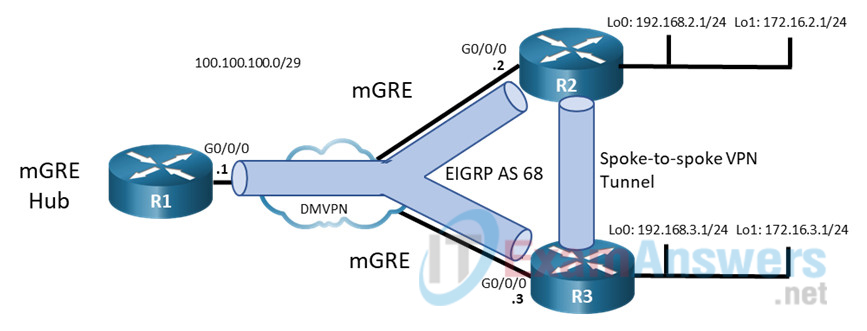

+ R2 to R6 are running BGP AS 65002 while R1 is running BGP AS 65001 + R1 is working as the DMVPN Hub router while R7 & R8 are working as DMVPN Spokes Below is the topology for this challenge. I will discuss more about phase2 and phase3 tunnels in my upcoming blogs.This lab challenge helps you understand more about DMVPN. Sending 5, 100-byte ICMP Echos to 192.168.10.2, timeout is 2 seconds:

Now traffic initiated from SPOKE to SPOKE to bring up dynamic spoke to spoke tunnel. *Apr 16 23:26:27.443: %SYS-5-CONFIG_I: Configured from console by console # Ent Peer NBMA Addr Peer Tunnel Add State UpDn Tm Attrb UpDn Time -> Up or Down Time for a Tunnel NHS Status: E -> Expecting Replies, R -> Responding # Ent -> Number of NHRP entries with same NBMA peer Legend: Attrb -> S - Static, D - Dynamic, I - Incomplete ISP Router(Symbolic): ip dhcp excluded-address 10.10.10.1 Here as well…we need a Dynamic way to achieve the connectivity.įollowing is a simple 3 site configuration for DMVPN…. Can you make static GRE tunnels? static tunnels need static source and destination configuration. How do you think you can connect with this site. Basically they are connected via DSL router which refreshes the IP address on daily basis.

Problem-2 : You do not know the public IP address of your remote location. We must have a dynamic way to connect to a hub site. Do you think adding and deleting sites on daily can be a good practice? think about the manual work of configuring hundreds of DMVPN tunnels. You connect those sites with GRE tunnels. Problem-1 : You have huge number of sites and you add and delete sites on daily basis. In this article I will explain why do we need it and how to configure it. DMVPN or Dynamic multipoint VPN is a widely used technology.


 0 kommentar(er)
0 kommentar(er)
